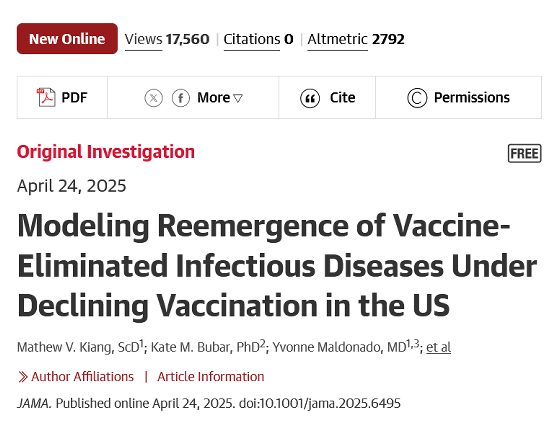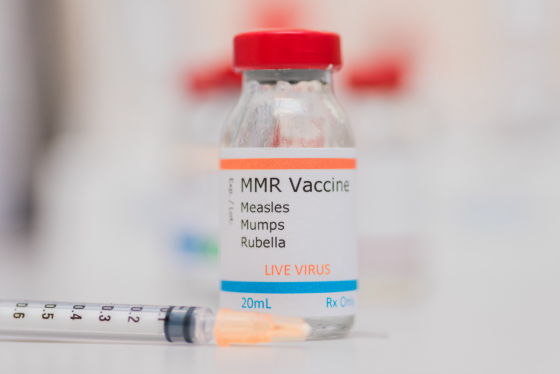Even a small drop in vaccination rates could lead to a measles epidemic.

Modeling Reemergence of Vaccine-Eliminated Infectious Diseases Under Declining Vaccination in the US | Infectious Diseases | JAMA | JAMA Network
https://jamanetwork.com/journals/jama/fullarticle/2833361

How a small vaccine drop could see measles becoming endemic again – new study
https://theconversation.com/how-a-small-vaccine-drop-could-see-measles-becoming-endemic-again-new-study-255327
Measles is an infectious disease that causes symptoms such as high fever and rash, and there is a risk of complications such as pneumonia and encephalitis. In particular, encephalitis occurs in approximately 1 in 1,000 people, and about 1 in 100,000 people may develop subacute sclerosing panencephalitis (SSPE), an encephalitis for which there is no treatment, several years after measles has been cured. The mortality rate of children who develop measles is said to be 1 to 3 per 1,000, which is much higher than that of colds and influenza.
Another reason why measles is considered particularly dangerous is its high contagiousness. The basic reproduction number, which indicates the expected number of people who will be directly infected when one infectious patient joins a group of people who are not immune, is said to be '12 to 18' for measles . Even influenza and COVID-19, which are generally considered to be highly contagious and are frequently reported to be epidemics in workplaces and schools, have a basic reproduction number of '1 to 4,' which clearly shows how contagious measles is.
To prevent measles from being transmitted from person to person, at least 95% of the population needs to be vaccinated. However, vaccination rates have been declining worldwide in recent years, and it has been reported that in 2024, only 84% of 5-year-olds in England had received two doses of the new MMR vaccine , which combines the vaccines for rash, mumps , and rubella .

A research team from Stanford University, Baylor College of Medicine, and others used a simulation model to examine the impact of increases and decreases in vaccination rates on epidemics such as measles. The simulation model covered all 50 states and the District of Columbia in the United States, and evaluated scenarios with different childhood vaccination rates over the next 25 years.
The simulation results showed that if the current vaccination rate at the time of writing is maintained, the number of measles cases will reach approximately 851,300 over the next 25 years, and measles is likely to once again become endemic.
In addition, if the vaccination rate were to fall by 10% from the time of writing, the number of measles cases would reach approximately 11.1 million over 25 years, which could lead to an explosive epidemic. If the vaccination rate were to fall by 50%, 51.2 million people could develop measles over the next 25 years.
On the other hand, if the vaccination rate had increased by 5% from the time of writing, the number of measles cases over 25 years would have been only 5,800, significantly reducing the epidemic. These results show that even a small decrease in childhood vaccination rates can cause an explosive measles epidemic, while even a small increase in vaccination rates can dramatically reduce epidemics.

Anastasia Theodosiou, a lecturer in infectious diseases and microbiology at the University of Glasgow, who was not involved in the study, and her colleagues said that measles and other infectious diseases are still endemic in countries where vaccines are not widely used. However, they pointed out that even in countries where measles has been almost completely eradicated through the widespread use of vaccines, it could become endemic again if vaccination rates fall.
There are various reasons for the decline in vaccination rates worldwide, including the hassle of vaccinating children, concerns about side effects, and underestimation of the risk of infection. In particular, with regard to the underestimation of the risk of infection, there is an ironic situation in which measles patients have almost disappeared due to high vaccination rates, and as a result, the risk of measles has become difficult to recognize. 'In this respect, vaccines are a victim of their own success. It may be difficult to imagine the impact of infectious diseases that have almost disappeared thanks to vaccines,' say Theodosiou et al.
The main cause of vaccine hesitancy is misinformation spread through social media, with a 2021 survey finding that just 12 anti-vaccination people were responsible for two-thirds of the anti-vaccination content spread on Facebook and Twitter. Some experts have also pointed out that media reports may be part of the cause of vaccine hesitancy.
In 1998, a paper was published claiming that the MMR vaccine was associated with autism, and it is still supported by people who avoid the MMR vaccine, but it has been found to be false and based on fabricated data. The author of the paper, Andrew Wakefield, has already had his medical license revoked, and research results that refute the results of the paper have also been reported.
It is shown that the new triple vaccine is unrelated to autism - GIGAZINE

in Science, Free Member, Posted by log1h_ik